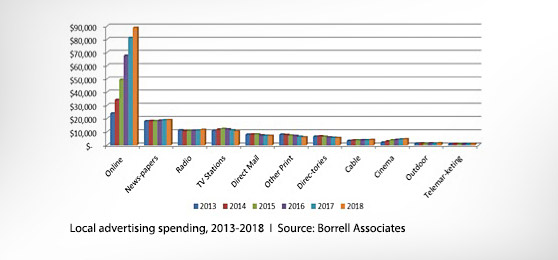In just only a few decades, the way we conduct marketing has changed rapidly. To my surprise, I have found there are tactics that still work and more effective than the more recent methods.
Traditional marketing is the process of researching and promoting your business through a certain set of channels before the creation of the internet.
1. What Is Traditional Marketing
Traditional marketing is the process of using both outbound and inbound strategies to leverage your business.
However, the way we use these strategies are slightly different from the more modern digital approach.
1.1 Outbound Marketing
The first approach of traditional marketing is outbound marketing.
Outbound marketing is the method to reach out to people directly and initiate the conversation.
Furthermore, we reach out to people in the market by knocking on people’s doors, approaching them on the streets or ringing them on the phone. In particular, we know these methods as cold calling because the sales people do not ask for permission.
The purpose is trying to persuade people into your store and make a purchase. This being a short term strategy, as you are looking for instant results.
In addition, this approach is more commonly associated with traditional marketing, and is less effective than the inbound approach (I discuss this in the below section).
Mainly because when a stranger approaches you, you are naturally in a more defensive position. As well as, feeling annoyed from the disruption.
After all, as children our parents always informed us to avoid strangers (this makes you less open to outbound the sales pitch).
Overall, this can result in the sales people coming across as being more aggressive as they have to push their message out on the world. Academics refer to this as interruption based marketing because it involves imposing yourself on people in their day-to-day lives.
This aspect of traditional marketing seems more aggressive as it involves approaching you without your permission.
1.2 Inbound Marketing
The second approach to traditional marketing is inbound marketing.
This is generating interest by hosting a platform where people can come and join your conversation (by which they can share their opinion).
This triggers people’s interest because they want to be a part of the popular discussion.
A good inbound strategy is inserting your business into a popular conversation as it will subtly pull people towards your business.
One of the most effective inbound forms of marketing we still use today is content marketing. We do this through newspapers, flyers and whitepapers.
In addition, inbound is also reward driven. This includes building brand awareness for businesses through offering prizes out to people that choose to participate.
Like all inbound methods, each creates something informative that is of genuine value and interest to people. By offer real value, the target audience end up approaching you and your business.
People value those things that improve their life and make them happier. As I am sure you also like to be part of the latest discussion and development of the world.
2. Why Is Traditional Marketing Important?
There is no denying that modern digital marketing channels are more effective than the traditional means of business.
However, we cannot forget that traditional marketing actually laid the groundwork for the greatest form of marketing that we have seen today.
An example of this is Search engine optimisation (SEO) and it is heavily relied on content marketing. By leveraging content on your website, you get put on search engines and found for free.
That is you also cannot deny that people value face-to-face relationships over digital ones. This means a business leveraging constructive tradeshows and events is so much more powerful (if done right).
If you are a business then it is equally important to hold events and sponsor charities for brand recognition.
What’s more this impression of goodwill does without a doubt increase your identity of trust and can help your business grow.
Politicians do this all the time and they are more effective for gaining support than an online campaign.
You may not realise it but by attending a political event, you are buying into an ideological system.
3. Traditional Marketing Objectives
There are two main objectives when it comes to traditional marketing. The first is building brand awareness and the second is developing sustainable products.
3.1 Brand Awareness
Brand awareness is ensuring the market know who you are and what you sell so that when people are in need of your service then they think of what you sell.
What’s more, powerful brand awareness inserts recognition under an intended scenario the customer may face.
3.2 Product Development
You want to conduct product development to understand how well your products against the competition.
To quote Steve Blanc (an entrepreneur guru), there is no better way to do this than getting out the building. If you are building a new product and want to achieve product market fit then you need to speak to people and watch how they interact with your business face-to-face.
We do this specifically through market research and this includes undergoing tests, observations and tapping into public opinion in either a controlled and uncontrolled environment.
In a controlled environment, you will test how your product performs against the competitor’s products.
In less controlled environments, you observe how customers interact with your product in their day-to-day lives. The insight these test is to gain customer satisfaction to understanding why people purchase your products to reduce customer retention.
4. Three Pillars Of Traditional Marketing
The three pillars of marketing is broken down into traditional market research, traditional channels and traditional analysis.
4.1 Three Pillars of Traditional Marketing Model

Traditional marketing is broken down into three forms: Traditional market research, traditional analysis and traditional channels. We discuss these in more detail below…
5. Traditional Market Research
Traditional marketing research is the manner in which you assess the market. The main aim here is to understand the experiences people have with your business.
People experience pleasure through rational and emotional effects. In short, we aim to understand:
- Sensory – Sight, sound, touch, taste and smell
- Think – Physical experiences, behaviours and lifestyles
- Act – Social identity and experiences from a related group or culture
After gaining these insights, we can create holistic experiences that integrate individual experiences into a holistic Gestalt.
5.1 Traditional Market Research Methods
There are four ways to conduct traditional market research. This includes observation, surveys, interviews and focus groups.
5.2 Observation
Observations include observing people’s behaviour to understand how they operate your products in both a controlled or uncontrolled environment.
It can also include counting how many people entered your shop over the year or how many products you sold that year.
5.3 Surveys
To survey someone will include approaching them on the street, at their home or mail and discuss their thoughts of a brand, product and overall opinions.
5.4 Interviews
This will include asking individual people questions about their opinion on related questions you may have within your business.
5.5 Focus Groups
This will include asking a group of people questions about their opinion on related questions you may have within your business.
Overall, traditional marketing research assesses the overall market by using questions to discuss customer’s thoughts of your product and understanding underlying reasons why they either like or dislike something.
6. Traditional Data Analysis
When you collect information using the traditional methods (named above), you also need to assess this information in a certain way.
Unfortunately, because how we collected this information, it will require us to process this information manually.
This makes it a lot more of a timely process (than the automated digital method such as Google analytics).
Through surveys, observation and more quantitative methods will include manually inserting data into a database. This will then be analysed through computer processing power.
Through interviews, focus groups and more qualitative methods will include transcribing interviewee text into coded information. This helps us more easily understand the wants and needs of the interviewee.
7. Traditional Channels
Traditional marketing is a rather broad category that incorporates many forms of advertising. It is the most recognisable type of marketing, about advertising on a mass scale.
The traditional channels for promotion are:
- Print Marketing (newspapers and flyers)
- Broad Cast (TV and Radio)
- Direct mail
- Telemarketing
- Billboards
7.1 Print
Print defined as advertising in paper form. This means advertising on mediums such as newspapers, brochures, magazines and newsletters.
7.2 Broadcast
Broadcast is advertising on analogue source. This includes advertising on radio, television and on-screen movie theatre commercials.
7.3 Direct Mail
Direct mail is using printed materials and mailed directly to customers. This includes flyers, postcards, brochures, letters, catalogues and flyers.
7.4 Telemarketing
Telemarketing is trying to produce sales by calling and cold calling to people over the phone.
8. The Benefits Of Traditional Marketing Over Digital Marketing
Marketers have been using traditional market research methods for centuries now. The reason we still use these methods, even to this day, is that they are very effective, and provide us with a rich data set. For three reasons:
The first is that there are better benchmarks. We have used traditional market research resources for a longer period; this means there is more data to measure against our results.
The second is that it is easier for researchers to explain how the obtained their results. Traditional methods make it easier for researchers to explain exactly how they got their results.
The third and most important is the quality of information. Surveys and polls are a known to extract quality information and market insights we cannot extract from the modern digital method. Even though we can automate the way we process digital information at the click of a mouse, it lacks the emotional context.
Research shows us that only 7% of communication verbal. This leaves 93% of information being communicated none verbally. The only way to tap into this is face-to-face, to understand how a person really feels.
Although, there have been attempts in the digital world to get around this by engaging on social media with people. Nevertheless, it cannot compare, as people are not always honest and it is hard to decipher this behind a computer monitor.
9. Decline Of Traditional Methods
The internet has become an extremely crowded place as the slower corporate businesses play catch up to the trending digital usage of advertising (Resource Centre, 2017).
9.1 Advertising Spending From 2013 – 2018

The corporate world is slower to adapt and has permitted room for smaller enterprises and internet stars to become celebrities overnight.
In the past four years, Pewdiepie has grown up to 67 million followers and on-going revenue of 7.5 million dollars a year by just playing video games in his bedroom.
These people have become extremely influential on the internet. The blue ocean strategy explains why these people have been so influential. The blue ocean strategy highlights new markets and highlights highly competing markets.
Incidentally, when we released the internet there was a lot of unexplored territory and very few businesses online. This meant opportunity for anyone who took initiative to react quickly enough. It was not long before consumers began to trust websites, which resulted in stars occupying their consumer’s demands.
The internet has now transformed into thriving consumer market place and those businesses that failed to react to the change paid the price. Such as, BlockBuster and HMV felt the consequences by liquidation.
The density of the traditional world businesses has gone digital for fear of their own survival. As a result, businesses are shifting from the traditional world because it’s fully occupied as Red Ocean and the open digital world as Blue Ocean to differentiate into their own business.
9.2 Transition From the Traditional World to the Digital World

The image illustrates the reality where the businesses are trending to position themselves in terms of marketing presence and spending demonstrating there is less Blue Ocean in the foreground.
Online spending, demonstrates more focused towards the digital world than the traditional world.
Traditional forms of communication appear to be losing effectiveness since the digital age. Nail (2005) reports show that 40% of people agree traditional advertisements are no longer a good way to learn about new products. 59% of people say they no longer buy products because of their advertising, and 49% of people say they no longer think advertising is entertaining.
Conclusion
Overall, traditional marketing is a more outbound marketing approach for a means of promotion. This means it is heavily relied upon reaching out to customers rather than having customer reach out to you.




![#50 Top Factors [Link Building & Penalties] For Off-Page SEO #50 Top Factors [Link Building & Penalties] For Off-Page SEO](https://allbusinesstoolkit.com/wp-content/uploads/2019/01/Off-Page-SEO-1.png)
